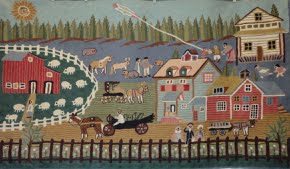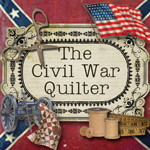
Thanks for all those who continue to share photos of Signature Quilt blocks that have a resemblance to the above painted plate I found on eBay a few weeks ago. I will continue to intersperse quilt blocks into this on-going story. (Click on photos to enlarge. You will be able to read some names.)
(The four WWII quilt blocks in this update are from my friend, *Sue Reich. See more about each block pictured here at end of this post plus information about Sue's new book about WWII quilts.)
After posting here last week, I contacted the Porcelain Painters International On-Line website and Marci Blattenberge, a member, was kind enough to answer my questions about the piece. She is trying to find out more through her own network of porcelain painters.

Marci wrote, "This is a beautiful and intriguing plate you have. Its the first one of its kind that I have ever seen but I can give you some input as to how it was done. I would also love to have your permission to post a picture of it on our PPIO forum for our members to see. Im sure they will also be intrigued with it.
First of all, the piece is definitely handpainted—at least, the floral is. The portrait in the center doesn't appear to be handpainted and I dont believe the signatures were directly written on the plate either.... but they may have been (difficult to tell without seeing it in person ).
"I suspect that the portrait and signature was a photo process that kinda got lost but recently is being rediscovered. There was a photo process that allowed photos to be fired into porcelain. It was popularly used to create photos that could be adhered to gravestones. A friend of mine tried to rediscover the process. There is actually a book that was printed around the turn of the century by the Campana company (you can still find copies of it sometimes in out-of-print bookshops) that outlines the process but the chemicals are no longer available. (From what I understand, you used to be able to get them from Kodak and it was a similar process to doing regular darkroom developing but using fireable china paints instead of the silver or whatever is used to make a photo.)

There is a process that has been rediscovered where you can make a decal using a laser printer that uses an iron-based toner. It is kiln fired, as this plate was. It also fires with a sepia color.
So, basically, I think that the portrait and the signatures were done with a photo process, creating a decal which was adhered to the glazed plate. The flowers were handpainted with china paints which are mineral oxide colors that come in a powder form, mixed with oil and painted on as you would paint on a canvas. (This is still the way we do it today.) The piece is then fired to about 1450 * F in a kiln. This melts the glassformers that are in the flux that is in the chinapaints and fuses the mineral oxides to the glaze, making them permanent.

Then the gold was painted on and refired. And, yes, it is real gold. It is powdered and mixed with oil, painted on, fired and then polished. It doesn't fuse with the glaze in the same way that the chinapaints do so gold is prone to rubbing off if rubbed hard. ( You see a lot of older china with the edges worn away.)
It's possible that the signatures were written directly on the plate. Its possible to thin chinapaint to a consistenly thin enough to run through a crow quill pen (like calligraphers use ).
This is a really intriguing piece... Quite a treasure !
I'm really glad you emailed. Marci
PS: Perhaps the girl who is pictured in the photo was also a quilter who decided to replicate the quilt pattern on a piece of china. I'm guessing that the quilts (if, as you say, they were a popular thing) was the inspiration for the plate and not the other way around."

References:
All four quilt blocks are from WWII era quilts can be seen in Sue Reich's book. Check out the Facebook page about Sue's WWII quilt exhibit here. See more about her quilt research here.
The red quilt block "plates" above are from a WWII quilt signed by members of auxiliaries of Kansas and Oklahoma. The white "plate" with red signatures is from Hazleton, PA. The multi-colored signature "plate" just above is from the W.S.C.S. (Women's Society Christian Service).

(from the publisher's website) Many American women made warm and attractive quilts to benefit U.S. soldiers during the period 1940-1945, either as outright gifts or as raffle items to raise money for good causes. This book reflects the author's extensive original research of newspaper and magazine articles of the era that feature these quilts. This work authenticates the patterns and designs available to quiltmakers and anchors the quilts historically in time. 335 color photos and descriptive text identify many colorful and patriotic quilts with military symbols and insignia, quilts made for donation to the Red Cross and organizations such as Bundles for Britain to raise money for the war effort. When possible, original patterns and designs that inspired the quilts are included. This work is important historically and emotionally to the appreciative families for whom these quilts, and thousands more yet to be discovered, were originally intended. Their legacies will continue because now these quilts can be interpreted from factual and objective perspectives.

My 1941- 42 Navy Signature Quilt will also be in this book. Click here t o see a complete list of all 250+ names posted on line in the Quilt Index Signature Quilt Project
*My friend, Sue Reich, also happens to be a Gold Star Mother. Her son, Major Stephen C. Reich, was a Westpoint graduate who gave his life in active military service to the citizens of the USA in 2005. Below is a Vogart pattern that was made during WWII for Gold Star Mothers.
Here are some links to some stories about her son, Major Stephen C. Reich:
New York Post - January 2014
Fox Sports News - May 2015
NPR coverage of Sue Reich's WWII Quilt Exhibit
Here is another great blogger who wrote on WWII Quilts also -- my friend Jean Carlton.







